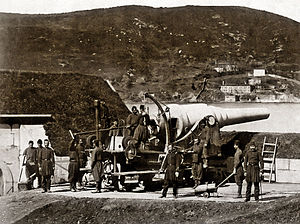Siege of Silistra
| date | March 1854 to June 24 , 1854 |
|---|---|
| place | Silistra |
| output | Ottoman victory |
| Parties to the conflict | |
|---|---|
| Commander | |
| Troop strength | |
| 12,000 | 80,000 |
| losses | |
|
28 dead, |
419 dead, |
Olteniţa - Akhaltsikhe - Başgedikler - Sinope - Cetate - Silistra - Nigojeti - Tscholok - Odessa - Kurekdere - Petropavlovsk-Kamchatsky - Alma - Sevastopol - Bomarsund - Balaklava - Inkerman - Yevpatoria - Taganrog - Çorğun - Kars - Tschernaja - Malakoff - Kinburn - Third Paris peace
The siege of Silistra was part of the Crimean War . The numerically vastly outnumbered Russian army had to break off the initially successful siege of the fortress Silistra after several weeks and withdraw.
prehistory
After the defeat in the Battle of Oltenița and the truce in the winter of 1853/54, the Russians began another offensive in the spring of 1854 on the Ottoman territory in what is now Romania . About 45,000 men crossed the border into Bessarabia and were able to take some fortified positions in the Dobruja . At the beginning of April, Russian troops crossed the ancient Trajan's Wall 30 km east of Silistra, by which time Mikhail Dmitrijewitsch Gorchakov had already begun the siege of the city.
The fortress Silistra, named by the Ottomans as Medzhidi Tabiya after their sultan and builder Abdülmecid , had been greatly expanded as a result of the Crimean War. In 1854, before the siege , the fort was reinforced with a new citadel and ten outlying forts . The commander, Musa Hulusi Pascha , had 12,000 men at his disposal, who were distributed among the various forts of the 2½ km long defense system on the right bank of the Danube.
The siege
On April 5, the first Russian units reached the left bank of the Danube in front of the city and began building entrenchments . On April 22nd, the Russian Commander-in-Chief Ivan Fyodorowitsch Paskewitsch arrived at the prepared positions with the bulk of his army. Further reinforcements reached the siege army on May 10th, which began to bombard the fortress. On May 28, after days of artillery bombardment, the first Russian attack on a key position, Fort Arab Tabia , was repulsed with heavy losses on both sides.
After this first Russian defeat, both sides began artillery duels. Paskevich was wounded and replaced by Gorchakov as commander. Omar Pascha was able to bring in a replacement army on June 10th. Another attack on the Arab Tabia Fort , which was supposed to enable the storming of the citadel of the fortress, was finally successful on June 20. However, this promising attack was canceled shortly before a tangible victory on the orders of Paskevich and Gorchakov had to withdraw his troops to the starting positions. Paskevich broke off the siege after 55 days in order to have a better starting position against the approaching Allied reinforcements from Varna . General KA Schildner , head of the Russian engineering corps, was killed in the fighting . On June 24th, the last Russian units left the positions in front of the city.
consequences
The Ottoman victory was made possible largely through the support of English, French and German military advisers. The defeat of the Russian army also prevented a breakthrough at this strategically important point and a possible attack on the Ottoman capital Istanbul .
The events were recorded in Namık Kemal's play Fatherland or Silistria! (1873) processed literarily.
literature
- Silistria . In: Meyers Konversations-Lexikon . 4th edition. Volume 14, Verlag des Bibliographisches Institut, Leipzig / Vienna 1885–1892, p. 976.
- Letters from headquarters or the truth about the war in the Krimm. Volume I, p. 45.
Web links
- Siege of Silistra (Engl.)

